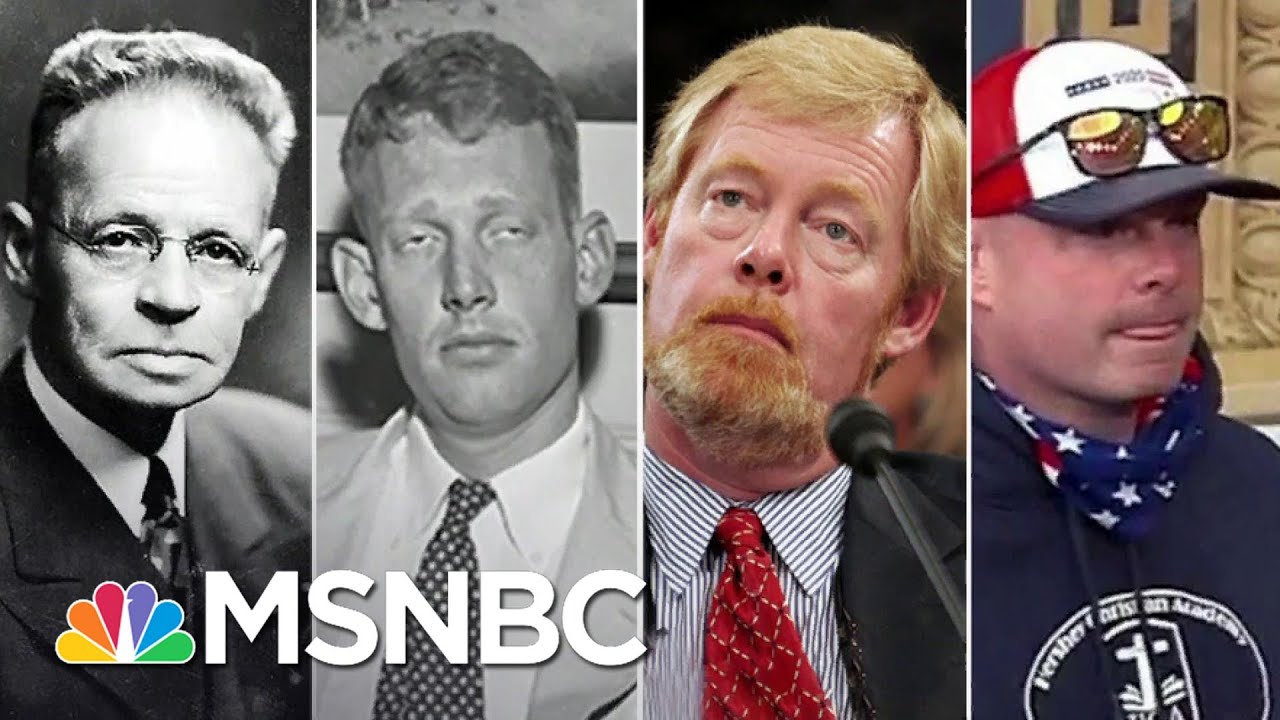From the American Legion to alleged insurrection: The story of American conservatism as told through four generations of L. Brent Bozells. Aired on 02/18/2021.
» Subscribe to MSNBC:
About All In with Chris Hayes:
Chris Hayes delivers the biggest news and political stories of the day with a commitment to in-depth reporting that consistently seeks to hold the nation's leaders accountable for their actions. Drawing from his background as a reporter, Hayes at times reports directly from the scene of a news event as it occurs to provide a firsthand account, digging deep and speaking with people who represent different points of view. Hayes brings the nation's officials, legislators, policymakers, and local activists to the table to address key issues affecting communities across America.
MSNBC delivers breaking news, in-depth analysis of politics headlines, as well as commentary and informed perspectives. Find video clips and segments from The Rachel Maddow Show, Morning Joe, Meet the Press Daily, The Beat with Ari Melber, Deadline: White House with Nicolle Wallace, Hardball, All In, Last Word, 11th Hour, and more.
Connect with MSNBC Online
Visit msnbc.com:
Subscribe to MSNBC Newsletter:
Find MSNBC on Facebook:
Follow MSNBC on Twitter:
Follow MSNBC on Instagram:
#Capitol #Insurrection#MSNBC
How One Conservative Clan Got To The Capitol | All In | MSNBC







I hope they all get years in prison
They are white and rich white racists still hold a lot of power. So I doubt it
Hilarious
That gene pool looks a little shallow…😁😂🤣
Turd doesn’t fall too far from the crack, apparently.
If I had DNA like that I’ll be hiding in a hole somewhere wishing I was dead
Yes !
Ur L. Brent Bozell – Came up with the idea of secession from the Union after Lincoln won the presidency in November 1860.
“In the Moonies cult, I was taught to suppress negative thoughts by using a technique called thought stopping. I repeated the phrase “Crush Satan” or “True Parents” (the term used to describe Moon and his wife, Hak Ja Han) whenever any doubt arose in my mind. Another way to control thoughts is through the use of loaded language, which, as Lifton pointed out, is purposely designed to invoke an emotional response. When I look at the list of thought-controlling techniques—reducing complex thoughts into clichés and platitudinous buzz words; forbidding critical questions about the leader, doctrine, or policy; labeling alternative belief systems as illegitimate or evil—it is astounding how many Trump exploits.
As I have mentioned, one of the most effective techniques in the thought control arsenal is hypnosis. Scott Adams, the creator of the cartoon Dilbert, described Trump, with his oversimplifications, repetitions, insinuating tone of voice, and use of vivid imagery, as a Master Wizard in the art of hypnosis and persuasion.”
“Nobody will be tougher on ISIS than me. Nobody,” he said during his campaign announcement speech on June 16, 2015. “There’s nobody bigger or better at the military than I am,” he stated a few days later. The following month came this memorably hypnotic line, one that echoes Moon’s language: “I know more about offense and defense than the generals will ever understand, believe me. Believe me. Than they will ever understand. Than they will ever understand.” It’s a classic example of Trump’s tried-and-true habit of lulling his audience through repetition. A few months later came another infamous claim: “I know more about the Islamic State militant group than the generals do. Believe me.”
“Cult members learn a new vocabulary that is designed to constrict their thinking into absolute, black-and-white, thought-stopping clichés that conform to group ideology. (“Lock her up” and “Build the Wall” are Trumpian examples. Even his put-downs and nicknames—Crooked Hillary, Pocahontas for Elizabeth Warren—function to block other thoughts. Terms like “deep state” and “globalist” also act as triggers. They rouse emotion and direct attention.)”
― Steven Hassan, Combating Cult Mind Control:
The #1 Best-Selling Guide to Protection, Rescue and Recovery from Destructive Cults
L Brent BOZO
Evil republicans!!!!!
L BRENT BOZO
A long line of ugly
The self righteous arrogance of the republican conservative mentalities is beyond pathetic anymore.
The problem is that Conservative does not mean wackos!
In 1984, with a briefcase in hand, Kerry Noble walked into a Kansas City, Mo church with intentions of blowing it up. He waited for his opportunity as he sat among a crowd of about 60 people.
“All I had to do was hit the timer and walk out,” Noble said. “About 10 or 15 minutes later, there’d be an explosion, and everyone would dye.”
Noble said he thought he was going to start a revolution. (Sound familiar?)
But as Noble sat among the crowd, he put a face to his “enemy.” And his “enemy” appeared no different than anyone else. He thought of the consequences–of what would have amounted to the largest terrorist attack in America at the time. Then, he picked up the briefcase and left.
Noble joined other former cult members and experts back in 2002 at APA’s Annual Convention in Chicago during the session “Cults of ha.tred” to speak out on the effects of mind control and destructive cults. To fully understand the psychological factors that lead to terrorism, the answers might lie in understanding cults.
Deborah Layton has encouraged more help for mind-control victims. “It can happen to the best of us,” Layton said. At age 18, in the early 1970s, Layton’s need for belonging attracted her to the Peoples Temple, a group that offered her a sense of comfort and answers to life. The leader, JimJones, made her feel like she was joining the Peace Corps. A few years later, Layton went to Jonestown.
“Everyone was forbidden from reading anything because Jones said they were liars,” said Layton. “He called it FAKE NEWS…. Jones coined fake news. Anything that was written about him he said was fake. It was all to ruin his name and his cause, and what he stood for.”
She escaped from Jonestown in 1978 and reported to police about activities there. She later said she felt ashamed at being warped into a cult. Steve Hassan, a former cult member and licensed mental health counselor who specializes in helping those in destructive cults, says recovery from a cult’s mind control can be facilitated if victims attain the proper information, support and interventions from former cult members.
A destructive cult is an authoritarian regime that often uses behavior modification on followers, such as thought- stopping techniques and instilling an “us-versus-them” mindset, Hassan said. With thought-stopping techniques, members are taught to stop doubts from entering their consciousness about the cult, often with a key phrase they repeat. Phobia indoctrination is also used, where cults play on a person’s irrational fears.
As we’ve all seen, when it comes to the warning signs and characteristics of a destructive cult, Trumpism”/Q” checks most of the boxes.
“People do not knowingly join cults that will ultimately destroy and kiii// them. People join self-help groups, churches, political movements, college campus dinner socials, and the like, in an effort to be a part of something larger than themselves. It is mostly the innocent and naive who find themselves entrapped. In their openhearted endeavor to find meaning in their lives, they walk blindly into the promise of ultimate answers and a higher purpose. It is usually only gradually that a group turns into or reveals itself as a cult, becomes malignant, but by then it is often too late.”
― Deborah Layton: A Jonestown Survivor’s Story.
😡😡😡😡😡 what it is
They did cause no damage like Blm not one statue was broken Blm has destroyed hundreds of statue
El Bozo Bozell IV.
More hardcore than Buckley. Wow. That’s really tough to do. Buckley was involved in the John Birch society! Clearly a dangerous family!
Hey guys, leaves some of your sisters to the rest of us!
Apparently stupid is inherited.